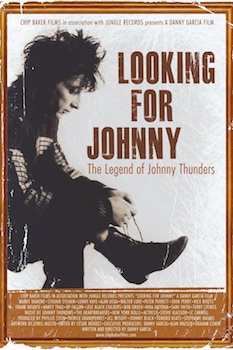It’s been a long time since the heydays of punk rock in New York City, and even a longer time since the original lineup of the New York Dolls took to the stage. Yet that period, since the Dolls formation in 1972, and the subsequent punk scene centred around the East Side of Manhattan starting in 1976, produced some of the most influential and controversial pop music artists of the late 20th Century. One of the most enigmatic and talented figures of the era was Dolls original lead guitar player, singer-songwriter Johnny Thunders
Born John Anthony Genzale in 1952, he died under strange circumstances in a New Orleans Hotel, April 23, 1991. Known for his heroin habit and hard living, it has been generally assumed he died of a drug overdose. To those not familiar with his story, Thunder’s life and death can be dismissed as just another case of a rock and roller wasting his life and potential via a needle in his arm. However, as the documentary Looking For Johnny: The Legend Of Johnny Thunders from director Danny Garcia recently released on DVD and distributed through MVD Entertainment Group shows, there’s more to his story than you’d think.

The documentary is the usual mix of interviews and archival footage we’ve all come to expect from this kind of film. However, director Garcia and his editing team have done a great job of seamlessly cutting the interviews and other footage to give us a chronological account of Thunders’ life. They’ve also done an excellent job of establishing the background against which his early career played out against. New York City was a much different place in the 1970s and early 1980s than it is today. Close to bankrupt, crime -riddled Manhattan, especially its Lower East Side, was a haven for drug dealers and struggling musicians needing cheap housing. It was here, in old warehouses and cold water walkups the new music scene developed.
As the movie follows Thunders’ musical trajectory over the course of his life, from high school bands through his membership in the New York Dolls, the seminal punk band The Heartbreakers with Richard Hell, and his attempts at a solo career, we learn that he was not only a dynamic performer, but also a prolific and accomplished songwriter. As his former bandmate in The Dolls, Sylvain Sylvain, says when talking about arguably Thunders’ best known song, “You Can’t Put Your Arms Around A Memory”, when someone like Bob Dylan says they wish they wrote a song, you know its great.
However, even more importantly we learn how much he was loved and/or respected by those who knew him. While he might have careened through most of his adult life, addicted to drugs, the majority of those interviewed in the movie only speak of how much he meant to them. Sure, he pissed them off at times, and he was impossible at other times, but they still stuck by him, and remember him with affection and or sorrow. We are left with an impression of a vulnerable individual who was his own worst enemy, but deeply loved in spite of his faults.
While there is no escaping the fact drug and alcohol abuse was responsible for killing his potential for a financially successful career, there’s also no denying the influence he had on popular music. He might never have achieved fame in North America save as an underground star, he toured extensively through-out Europe and Japan both as a member of his various bands and as a solo act and his music influenced everyone from The Sex Pistols to Morrissey. Any question you might have about Thunders’ abilities will be laid to rest by the archival footage of his solo acoustic performances. There is something so incredibly raw and vulnerable about the sight and sound of him standing on stage with his guitar it can bring tears to your eyes.

When he was able to open himself up to his music, rid himself of the demons which tormented him, and drove him into the arms of addiction, he shone with the light of true inspiration. It would be easy to dismiss Thunders as another example of a great talent gone to waste through the deprivations of drugs and alcohol, but as the movie makes clear, his death was more than a case of another guy simply overdosing. Garcia and his crew were able to obtain a copy of the coroner’s report on Thunders’ death and it puts things in an entirely different light as it indicated his body showed all the signs of him being in the later stages of leukaemia.
Interviews with friends who saw him in the months leading up to his death confirm they were worried about his health. He had admitted himself to a detox centre, and was on a methadone program in an attempt to get himself clean, yet he looked to be sicker than ever. Phyllis Stein, the former partner of his long-time friend and fellow Doll and Heartbreaker, the late Jerry Nolan, talked about the last time Nolan saw Thunders before he left New York City for New Orleans. She says Nolan came home shaken and described Thunders as being covered with bruises where there shouldn’t have been any. Stein then tells us how her mother had died of leukaemia when she was a child, and how in the later stages of the disease she displayed the same symptoms.
Yet, in spite of knowing he was very sick, and probably knowing he was dying, from all accounts, Thunders was doing his best to get clean. Instead of doing his best to continue with his seemingly endless quest to escape reality, he seems to have in the end resolved to at least attempt to meet his death face on. Nobody knows for sure what happened the night he died in a New Orleans hotel. The police never looked into why his room had been picked clean of all his money and possessions, or why riga-mortis had frozen him in a foetal position when they finally found him. They just dismissed it as another junkie death.
As Searching For Johnny – The Legend of Johnny Thunders makes perfectly clear, Thunders was more than just another junkie. Nearly 25 years after his death he is still remembered and talked of fondly by his friends and those he played music with. Music he wrote more than thirty years ago is still being played and sought out around the world. You might not be able to put your arms around a memory, but this movie helps to keep the memory of Johnny Thunders alive and reminds us of what he meant to both popular music and those who loved him. If you’ve never understood what all the fuss is about, watch this movie and it will give you at least a glimmer of understanding into the life and times of one of rock and rolls’ great talents. If you did know of him, or know him, watching this movie will break your heart all over again.
[amazon template=iframe image&asin=B00MA152QY]
 Blogcritics The critical lens on today's culture & entertainment
Blogcritics The critical lens on today's culture & entertainment



